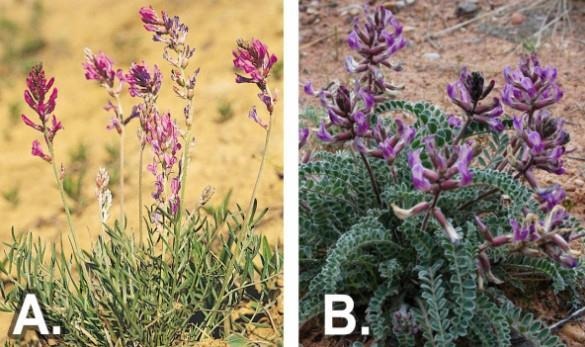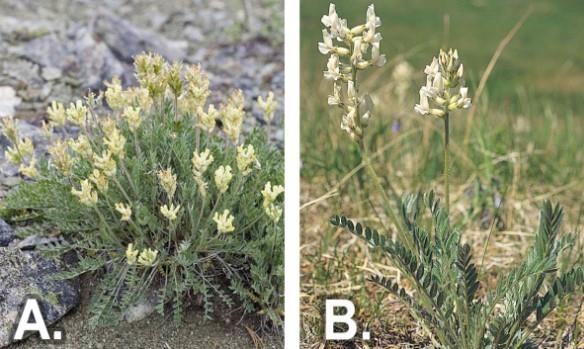In this article of the Poisonous Plants on Rangelands series, locoweeds and crazyweeds are discussed. The names locoweed and crazyweed are often used interchangeably, however, there are notable differences between the species. Both species are found throughout South Dakota rangelands and can cause livestock poisoning.

Figure 1. Astragalus genus (left) with blunt keel petal and Oxytropis genus (right) with pointed keel petal. Courtesy: SDSU Extension © 2016, South Dakota Board of Regents.
Locoweeds and Crazyweeds
Locoweeds get their name from the Spanish word “loco,” which means crazy. Both locoweeds and crazyweeds cause a condition called locoism or loco poisoning in livestock. The term locoweed or crazyweed is often interchanged between species; however, locoweeds belong to the Astragalus genus, while crazyweeds belong to the Oxytropis genus. Locoweeds can be differentiated from crazyweeds by the keel on their flowering seed head. Locoweeds have a blunt keel, whereas crazyweeds have a pointed keel. Both are prolific seed producers, and seed can remain viable in the soil for several decades.

Figure 2. A) Lambert crazyweed (Purple Locoweed). Courtesy: SDSU Extension © 2016, South Dakota Board of Regents. B) Woolly locoweed. Note the leaves and flowers are on stems, in contrast to lambert crazyweed. Courtesy: Colorado State University.
LAMBERT CRAZYWEED
Lambert crazyweed (or purple locoweed) (Figure 2-A) has basal, pinnate leaves that arise directly from the crown with an erect, raceme flowering seed head that starts to appear in May to early July and is pinkish-purple and sometimes more rose-colored. The plant has a silver-like, pubescent coloring and is the most common locoweed throughout the South Dakota prairies.
WOOLLY LOCOWEED
Woolly locoweed (Figure 2-B) has a similar appearance to lambert crazyweed, except its leaves and flowers are on stems instead of originating from the crown like is seen in lambert crazyweed. Woolly locoweed is usually only found in the southwest corner of South Dakota.

Figure 3. A) Slender crazyweed. Courtesy: University of Washington. B) White crazyweed. Courtesy: SDSU Extension © 2016, South Dakota Board of Regents.
SLENDER CRAZYWEED
Slender crazyweed (or plains locoweed) (Figure 3-A) has a dense, spikelike, raceme seed head that is cream to light-yellow colored and flowers from June to August; and hairy basal leaves extend from the branched crown. Slender crazyweed is commonly found throughout the Black Hills region at mid-to-high elevations.
WHITE CRAZYWEED
White crazyweed (Figure 3-B) has a creamy-white, erect, spikelike, raceme flowering seed head that appears in May to June and dense, robust, basal leaves with silky hairs that branch from the crown of the plant. White crazyweed is occasionally found in the Black Hills region at low-to-mid elevations.
Locoweeds are the number one cause of livestock losses from poisonous plants in the western United States. Some species of livestock will crave and become addicted to loco or crazyweeds after getting a taste of the plant. When livestock continually ingest loco or crazyweeds, they develop locoism, a chronic neurological disease caused by alkaloids, which causes livestock to exhibit “crazy” behaviors. Symptoms generally develop in six to eight weeks after grazing toxic amounts of loco or crazyweeds (amounts are plant and animal species dependent) and include listlessness and depression with lowered head, weakness and loss of coordination, paralysis, inability to eat or drink and eventually death. Animals suffering from locoism are easily stressed and can become violent or dangerous.
Source :